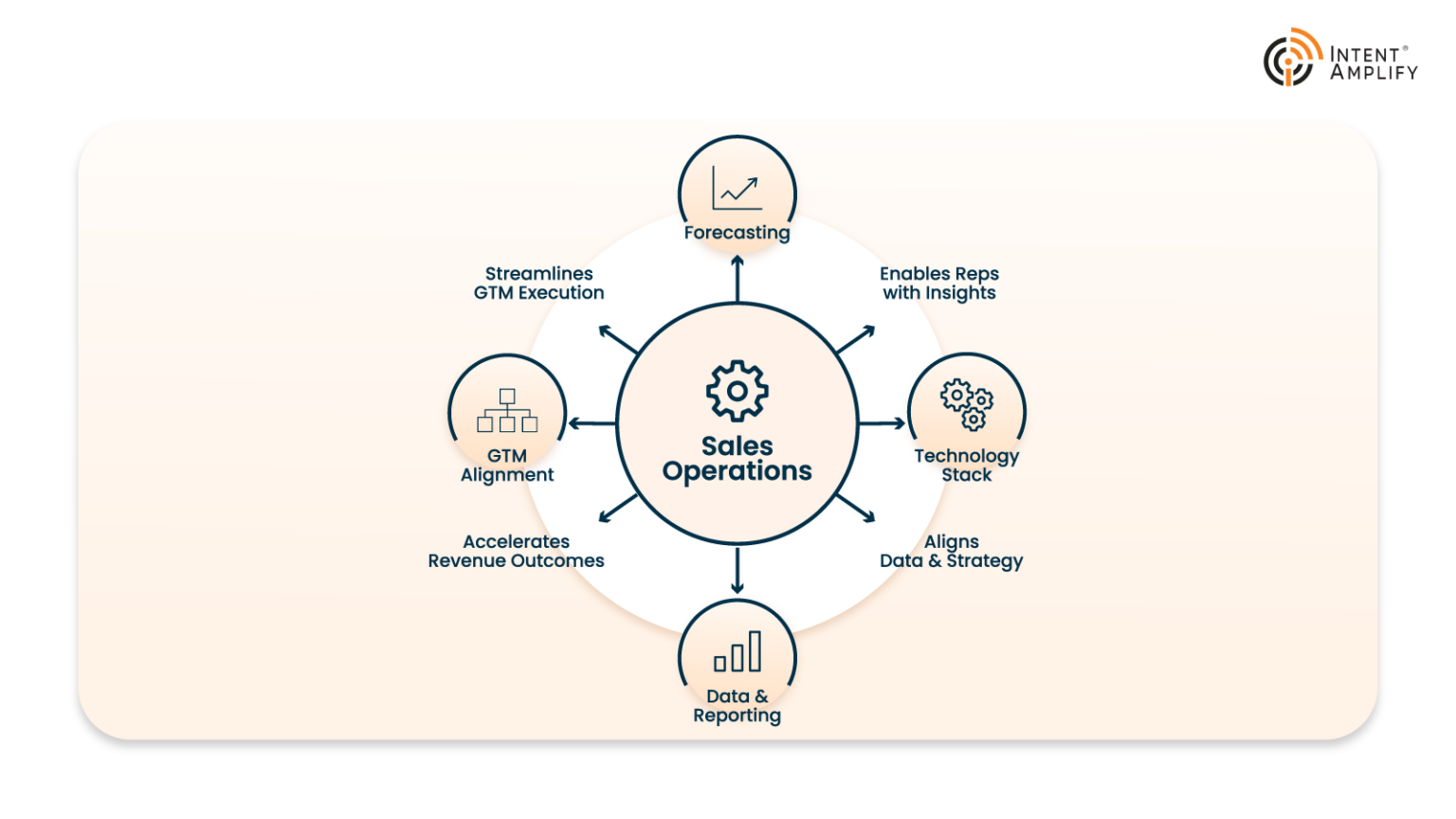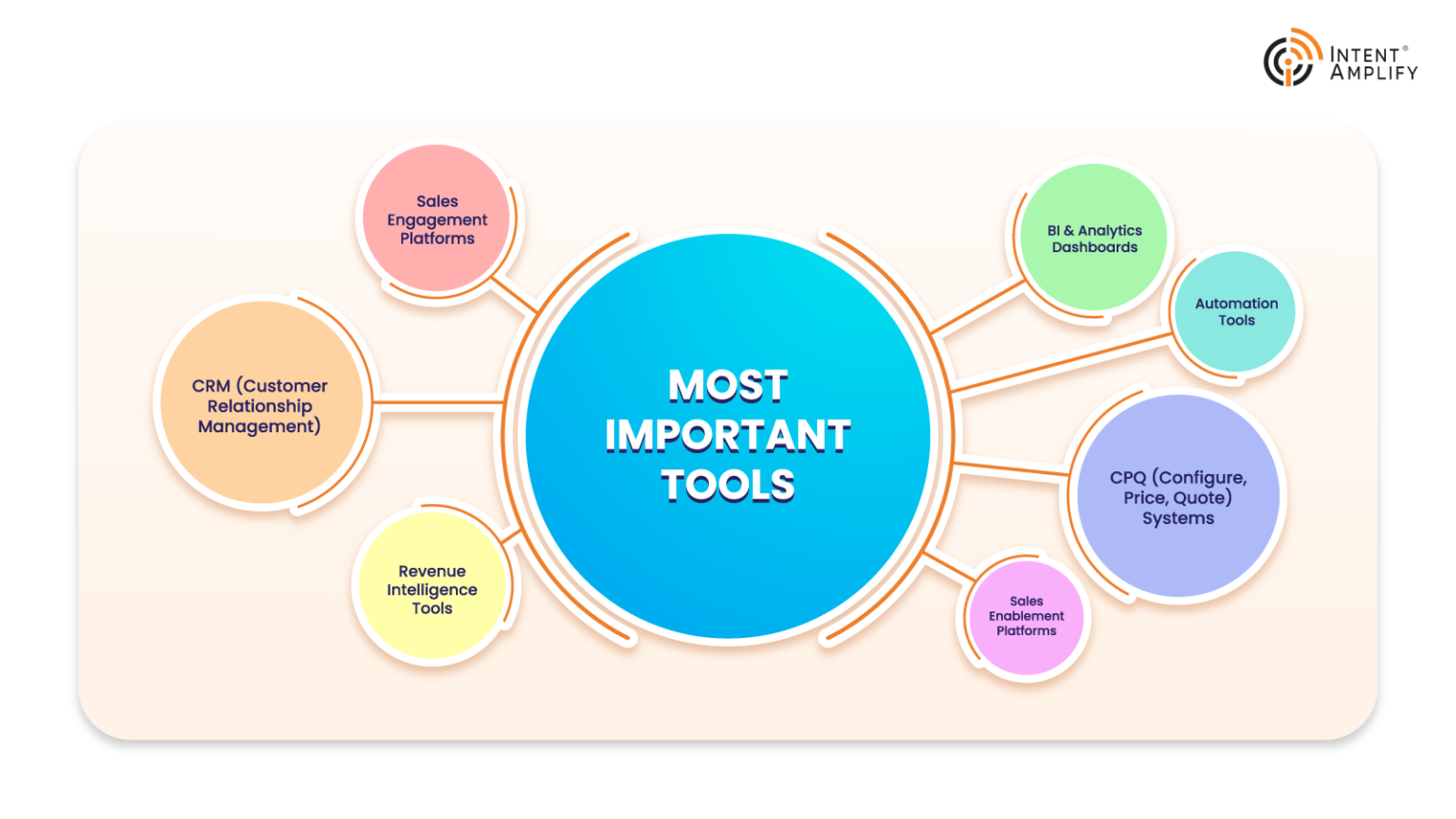
5 Proven Strategies to Optimize Your Sales Operations in 2025
- Last updated on: July 8, 2025
What’s the one function in your sales team that doesn’t sell, but determines whether you close or lose? In the modern B2B landscape, it’s not always your top closer or biggest account that drives momentum; it’s your sales operations engine working behind the scenes. While reps focus on the deal, sales ops orchestrate the systems, data, and workflows that make those deals possible.
In 2025, where buyer journeys are longer, GTM teams are more complex, and speed-to-insight defines a competitive edge, sales operations have become a strategic pillar of revenue growth. It’s no longer just about enabling reps, it’s about building a performance machine that scales with clarity and control. This article walks you through five proven strategies to optimize your sales operations in 2025, giving you the clarity to operate smarter, grow faster, and sell with precision.
What Is Sales Operations?
Sales operations form the foundation of a high-performing sales force. It is the processes, systems, tools, and data that enable frontline sales teams to perform their functions properly. From territory design and performance measurement to CRM management and sales enablement, sales operations ensure sellers are enabled, aligned, and set up to drive revenue. No longer a back-office function, it is today a strategic ally to sales leadership, enabling scale, speed, and accuracy throughout the entire revenue engine.
Key Functions of Sales Operations:
- Sales Forecasting & Planning: Creates precise projections and quota models.
- Performance Analytics: Monitors critical KPIs, win rates, and pipeline health.
- Process Optimization: Develops repeatable, optimized sales processes.
- Tech Stack Management: Owns CRM infrastructure, automation, and integrations.
- Territory & Quota Design: Assigns resources by market opportunity.
- Compensation Management: Designs incentive plans aligned to business objectives.
- Cross-Team Enablement: Aligns marketing, sales, and customer success.
Through coordinating these functions, sales operations create the foundations for data-driven, predictable growth, making sales a strategic asset rather than a reactive function.
Why Does Sales Operations Matter?
In 2025, sales operations no longer have an ancillary role; it’s a growth driver. As B2B sales processes continue to grow more complicated and buyers’ expectations shift, firms that invest in strong sales operations outperform peers. A well-organized sales ops organization reduces inefficiencies, harmonizes GTM efforts, and empowers leadership to make data-driven strategic decisions. In addition, sales operations directly affect revenue performance.
Why It’s Important in 2025:
- Complex Buyer Journeys: Sales ops inject order into non-linear B2B buying journeys.
- More Tech Dependency: It guarantees smooth integration across platforms such as CRM, AI, and CPQ.
- Requirement for Real-Time Insights: Sales leaders require up-to-date visibility into performance and pipeline.
- Revenue Responsibility: Sales ops converts strategy to execution, and execution to results.
- Talent Optimization: Aids rep onboarding, coaching, and retention by developing high-performance environments.
When done correctly, sales operations not only enable your sales organization, it enable your entire GTM machine to move with clarity, confidence, and quantifiable impact.
What Does Sales Operations Do to the Sales Process?
Sales operations take the sales process from broken to seamless. It introduces discipline to forecasting, consistency to onboarding, transparency to performance metrics, and a framework for sales methodologies. With sales ops on board, sales reps have more time to sell and less time fighting to get their systems and processes in order. From pipeline grooming to sales tech integration, sales operations are key to making the whole sales process more predictable, measurable, and scalable.
Five Proven Strategies to Optimize Your Sales Operations In 2025
1. Unify Sales Data for Smarter Decision-Making
Data in 2025 is not only a resource, it’s a driver of revenue. And yet, many sales organizations still labor under the burden of disparate systems that hold customer data in CRMs, marketing automation software, spreadsheets, and sales engagement tools. The outcome? Inconsistent reporting, pipeline blind spots, and lost opportunities.
Having your sales data centralized in one place as a single source of truth changes the way your teams work. It enables sales operations to derive real-time insights that drive strategy, resource planning, and performance measurement. Sales leaders can better forecast. Reps can focus on the right accounts. Marketing can align with sales on common metrics.
It doesn’t involve ripping and replacing tools. Rather, it involves bringing platforms together throughout the tech stack from CRM to CPQ, so that data moves freely. Leverage tools such as RevOps dashboards and data orchestration platforms to align your sales intelligence. When data is available, structured, and actionable, your team sells smarter, not harder.
2. Automate Manual Tasks to Increase Productivity
Manual work quietly saps your sales team’s productivity. In 2025, with speed and accuracy becoming competitive strengths, it’s not a choice to automate tedious work, but a necessity. Sales representatives allocate as much as 30% of their time to non-revenue activities such as data entry, follow-up emails, and maintaining CRM fields. Sales ops have to cut through the friction.
Automation allows reps to excel at what they are best at selling. Whether it is lead routing and scheduling of meetings, pipeline status updates, and quote building, anything that can be automated should be. Automation tools such as Salesforce Flow, HubSpot Sequences, or AI-enabled assistants can be utilized by sales ops to execute routine tasks with precision and speed.
In addition to time reduction, automation guarantees that tasks are carried out right every time. It minimizes the risk of human mistakes, streamlines workflow, and decreases the sales cycle. This also grants greater visibility into buyer actions and allows for more timely, more personalized interaction.
3. Align Sales Ops with GTM Teams for Seamless Execution
In 2025, isolated teams are revenue roadblocks. The sales operations have to be the glue that connects marketing, customer success, revenue operations, and finance. When sales ops are siloed, go-to-market (GTM) efforts collapse, leading to misaligned goals, competing KPIs, and lost revenue.
Alignment is not merely sharing meetings. It demands shared data, aligned processes, and cross-functional planning. Sales operations need to enable collaboration by establishing integrated workflows for lead handoffs, account scoring, pipeline forecasting, and customer lifecycle management. GTM teams need to work from one strategy with well-defined roles, shared definitions (such as what constitutes an SQL), and aligned reporting.
By advocating alignment, sales ops guarantee that all teams are moving in the same direction. This speeds up deal velocity, elevates conversion rates, and optimizes the buyer experience. Flawless execution begins with strategic integration throughout the GTM engine.
4. Redesign Sales Processes for Buyer-Centric Journeys
The contemporary B2B buyer in 2025 is educated, self-reliant, and demands a frictionless experience. Conventional sales processes that focus on internal workflows rather than customer requirements are not productive anymore. Sales operations need to re-engineer these processes based on the buyer’s journey, not the seller’s convenience.
This starts with mapping out each step of the customer lifecycle from initial contact through post-sale growth and determining the pain points, decision drivers, and preferred channels at each. Sales operations should then design processes that correlate to the way buyers research, compare, and buy solutions.
For instance, optimize qualification steps to minimize friction, leverage intent data to approach prospects at the right time, and equip reps with insights to provide timely, relevant messaging. Integrating technologies such as conversational AI, content engagement analytics, and guided selling platforms enables the operationalization of buyer-centricity at scale.
Yet despite these capabilities, only 25% of sales organizations currently achieve 75% or higher forecast accuracy, highlighting the urgent need to align sales processes more closely with buyer behavior and data-driven insights.
If sales processes reflect how buyers purchase, the outcome is faster sales cycles, improved close rates, and improved buyer satisfaction.
5. Invest in Sales Enablement That Drives Impact
Sales enablement in 2025 is no longer about random content libraries or one-off training sessions. It’s a strategic function that equips sellers with the right knowledge, tools, and messaging at every stage of the buyer journey, driving measurable impact on quota attainment and revenue growth.
Sales operations need to collaborate closely with enablement teams to make reps not only active but also effective. This involves creating systematic onboarding pathways, role-based learning journeys, battle cards, objection-handling playbooks, and real-time coaching materials. Just-in-time enablement—provided through CRM cues, guided playbooks, or AI suggestions makes reps aligned and agile in real-time sales scenarios.
Most importantly, contemporary sales enablement has to be data-driven. Sales ops need to monitor which assets drive closed business, which training modules are associated with high performance, and where there are holes in rep readiness. This feedback loop serves to hone enablement approaches and focus on what makes a difference.
What Are the Most Important Tools for a Sales Operations Team?
Success in sales operations in 2025 is all about how good your tech stack is at empowering your team. Each of the tools listed below is critical to delivering alignment, efficiency, and revenue performance across your B2B sales organization.
1. CRM (Customer Relationship Management)
CRMs are the single repository for all customer and pipeline data. They enable sales teams to monitor interactions, anticipate revenue, control deal stages, and split accounts. For sales ops, CRMs give visibility, standardization, and automation potential necessary for optimizing operations and allowing scalable processes in expanding teams. Examples: Salesforce, HubSpot, Zoho
2. Sales Engagement Platforms
These tools automate and individualize communication workflows so reps can engage prospects with email, phone, and social touches at scale. Sales ops teams leverage them to track engagement metrics, refine cadences, and maintain consistency in outreach, leading to quicker follow-ups and better pipeline conversion throughout the sales process. Examples: Outreach, Salesloft
3. Revenue Intelligence Tools
Revenue intelligence platforms break down rep conversations, pipeline progression, and deal health with AI. They identify risk indicators, suggest next steps, and enhance the accuracy of forecasts. To sales ops, such platforms provide valuable insights that enable leadership to make informed, data-driven decisions to drive the highest win rates and revenue velocity. Examples: Clari, Gong, Aviso
4. Sales Enablement Platforms
Sales enablement software offers reps instant access to training, content, and best practices that are specific to every stage of sales. These teams use these tools to reinforce sales techniques, accelerate onboarding, and make sure reps are always equipped with messaging and collateral aligned to buyer intent and business goals. Examples: Highspot, Seismic
5. CPQ (Configure, Price, Quote) Systems
CPQ systems streamline price complex models and speed up the generation of quotes. These systems ensure reps present accurate, compliant proposals with little manual intervention. For sales operations, CPQ tools cut down errors, remove roadblocks, and compress the quote-to-close process, making deal execution faster and more scalable in complicated B2B sales worlds. Examples: DealHub, Conga, Salesforce CPQ
6. BI & Analytics Dashboards
Business intelligence tools graph sales performance metrics in real time, enabling teams to monitor KPIs such as win rate, pipeline coverage, and rep productivity. Sales operations leverage these dashboards to bring insights to the surface, detect chokepoints, and inform strategic planning, so leadership makes decisions based on trends, not assumptions. Examples: Tableau, Power BI, Looker
7. Automation Tools
Automation tools get rid of drudgery by integrating systems and causing activity based on workflow rules. Syncing lead information, maintaining CRM fields, or sending reps alerts about changes is performed by sales ops using such tools to increase productivity, minimize errors, and allow reps to focus on selling, not data updates. Examples: Zapier, Tray.io, Salesforce Flow.
Sales Operations Is Your Competitive Edge in 2025
Sales operations have transitioned from an after-the-fact function to a strategic growth engine. With the speed of today’s B2B environment, optimizing sales ops is not discretionary; it’s a differentiator. From centralizing data to automating processes, aligning with GTM teams, redesigning the buyer’s journey, or empowering sellers with high-impact resources, every strategy has a direct positive impact on productivity, consistency, and revenue performance.
The winners of 2025 are businesses that approach sales operations as a force for ongoing improvement and scalable expansion. It’s not about doing more—it’s about doing it smarter, faster, and more in line with how B2B buyers behave.
Drive Smarter Revenue Growth with Intent Amplify
At Intent Amplify, we enable B2B businesses to unleash scalable growth by leveraging targeted sales strategy, intent-targeted targeting, and operational excellence. With our experience in synchronizing revenue teams and streamlining sales processes, you’ll never leave pipeline or performance to chance. Ready to make your sales operations a differentiator? Let’s talk.
FAQs
1. What are the key responsibilities of sales operations in 2025?
Sales operations now own data management, process optimization, sales enablement, tech integration, forecasting accuracy, and alignment across GTM teams. It’s a key driver of strategy and execution.
2. How do sales ops enhance sales productivity?
By automating repetitive tasks, centralizing data, and creating streamlined processes, sales ops help reps focus on high-impact selling activities.
3. What are the differences between sales operations and revenue operations?
Sales operations concentrate on enabling sales teams. Revenue operations (RevOps) is a more comprehensive approach—it lumps together sales, marketing, and customer success as one single GTM engine.
4. What are the key tools for sales ops teams?
CRM platforms (e.g., Salesforce), enablement tools (e.g., Highspot), automation software (e.g., HubSpot Sequences), and analytics dashboards (e.g., Tableau or Clari) are essential tools.
5. What can small B2B teams gain from sales operations?
Even lean B2B organizations are aided by formalizing sales ops. With improved forecasting, streamlined processes, and connected technology, they become more agile and eliminate expensive inefficiencies.






